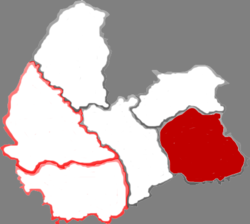Ying (Shuozhou)
| Yìng Xiàn 应 县 Ying |
||
|---|---|---|
|
|
||
| Coordinates | 39 ° 34 ' N , 113 ° 11' E | |
 Location of Ying within Shuozhou Location of Ying within Shuozhou
|
||
| Basic data | ||
| Country | People's Republic of China | |
| Shanxi | ||
| District-free city | Shuozhou | |
| ISO 3166-2 | CN-SX | |
| surface | 1708 km² | |
| Residents | 330,000 (2017) | |
| density | 193.2 Ew. / km² | |
| Website | www.yingxian.gov.cn | |
|
Sakyamuni Pagoda of Ying Buddha Palace Temple
|
||
Ying ( Chinese 应县 , pinyin Ying Xiàn ) is a Chinese district of the prefecture-level city Shuozhou in the province of Shanxi . It has an area of 1,708 km² and in 2017 had about 330,000 inhabitants. The 2000 population census showed a total population of 279,483 people in 73,861 households, including 145,102 men and 134,381 women. Its main place is the large community Jincheng ( 金 城镇 , Jīnchéng Zhèn ).
Ying is located on the Loess Plateau in the north of Shanxi Province and occupies the southern part of the Datong Basin. It has approximately 8,000 acres of forest and 80,000 acres of arable land.
Ying belonged during the Warring States Period to the state Zhao and was built during the Qin Dynasty part of the commandant Yanmen . Ying County was established as early as the Western Han Dynasty , which became Ying (应 州, Yingzhou) during the Tang Dynasty . With Li Keyong (military leader and king of Jin State ), Li Cunxu (emperor of the later Tang dynasty ), Xiao Yanyan , one of the most important civil servants and military leaders in Chinese history, and Empress Guo , Ying is intertwined with numerous personalities from the history of China .
Today the Rongcheng – Wuhai and Eren Hot – Guangzhou and Datong – Puzhou Railway pass through the Ying area. The Datong-Taiyuan high-speed line will be under construction in 2019.
Administrative structure
At the community level, Ying consisted of three large communities and nine communities as of the end of 2018 . These are:
- Large communities Jincheng (金城镇) Nanhezhong (南河种镇) Xiashe (下社镇)
- Communities Zhenziliang (镇子梁乡) Yijing (义井乡) Zangzhai (藏寨乡) Daihuangwei (大黄巍乡) Xingzhai (杏寨乡) Xiamayu (下马峪乡), Nanquan (南泉乡) Dalinhe (大 临河 乡), Baimashi (白马 石 乡)
The aforementioned administrative units are composed of 298 villages at village level .
Culture
There are numerous state-protected cultural assets in Ying County, including two monuments of the People's Republic of China and four monuments of Shanxi Province . These include the wooden Sakyamuni Pagoda of the Buddha Palace Temple , the Jingtu Temple , parts of the Wall of Qi State and 104 kilometers of the Great Wall of China from the Ming Dynasty .
Web links
- The wooden pagoda in Yingxian County: The largest and oldest surviving wooden pagoda in China
- Sakyamuni Pagoda at Fogong Temple
- The Sakyamuni Pagoda at Fogong Temple
- The Yingxian wooden pagoda
- Jingtu Temple
Individual evidence
- ↑ a b c d e f 应 县 概况.山西省 朔州 市 应 县 人民政府, accessed on July 8, 2019 (Chinese).
- ↑ 浙江省 乡 、 镇 、 街道 人口. State Statistics Office of the People's Republic of China , accessed June 11, 2019 (Chinese).
- ↑ 应 县. State Statistics Office of the People's Republic of China , accessed July 8, 2019 (Chinese).

